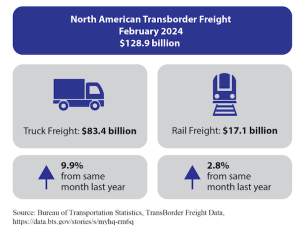Washington, D.C. - The Association of American Railroads (AAR) filed comments with the U.S. Department of Transportation (USDOT) today urging the agency to extend the same pro-innovation regulatory approach to private freight railroads that is afforded to highway vehicles. The filing, which also offers regulatory reform principles and calls for autonomous-vehicle technology to account for highway-rail grade crossings, is in response to USDOT’s request for comment on its recent publication, “Preparing for the Future of Transportation: Automated Vehicles 3.0” (“AV 3.0”).
“Not only will the public benefit from technology-driven safety gains in the rail industry, but it also will benefit if railroads remain a viable, competitive alternative to other transportation modes, thus ensuring the continued diversity and strength of the transportation network in the United States,” reads the filing, stressing the need for a mode-neutral approach. While the rail industry continues to improve safety and invest heavily in its network to serve customers, rapid innovation – facilitated through sensible and performance-based regulation at the federal level – is needed to achieve further advances.
“Increased automation will be key to continued efficiency gains, increased capacity to transport customers’ freight, further reduction of congestion on the highways, and increased fuel efficiency and emissions benefits,” AAR argues. “Autonomous technology has the potential to improve network velocity and fluidity, increasing rail capacity, and promoting the health and growth of the U.S. economy.”
AAR argues that by following a set of clear principles, safety aiding technologies will take greater hold moving forward. These principles include: 1) Barriers to deployment must be overcome outside of waivers; 2) Railroads and railroad equipment manufacturers should be permitted to create voluntary standards; 3) Regulations should be performance-based, rather than prescriptive; 4) Regulations must be federal to avoid a patchwork of state and local rules; and 5) the Federal Railroad Administration (FRA) must engage in the process.
“Safety is at the heart of all that the industry does, and by ensuring that federal policy enables innovation in the rail sector, we will continue to make a safe network safer,” said AAR President and CEO Edward R. Hamberger. “As our filing states, ‘safety is good business, and good business is good for safety.’ We applaud the USDOT for seeking thorough input from the full array of transportation stakeholders and welcome their effort to develop a paradigm most conducive to innovation and growth.”
AAR’s comments lastly address the interaction of autonomous-vehicle technology and automobiles at highway-rail grade crossings, noting that auto systems must be made in a way that will recognize and react to warning devices and approaching trains independently of train control systems. Positive Train Control (PTC), while important in stopping certain rail accidents caused by human error, simply cannot be used to combat incidents at grade crossings involving automobiles or pedestrians.







